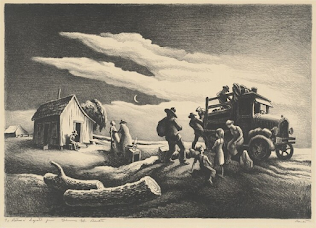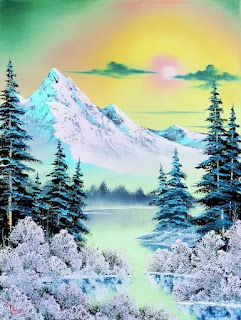Early Modern
Early Modern art and The Great Depression
The Great Depression started on August 1929. The known reasons for it was missteps by the Federal reserve, oversupply leading to over production, the stock market crash, the speculative boom of the 1920s. This lead to unemployment and failed businesses. This time people dealt a lot with high employment and small demand for workers, loss of homes and possessions. Artwork was used as a call out for help and a distraction to the people. Artists also used artwork to show how the world around them was changing they used abstraction a lot during this time.
A combination of the New Deal and World War II helped the U.S. overcome the Great Depression. In 1931 Franklin D Roosevelt went into presidency signing in the New Deal. The New Deal is new measures on banking industries and effort to get the economy back together.
Thomas Hart Benton created the artwork Departure of the Joads in 1939 in Hollywood, CA. The artwork was created for a movie named The Grapes of Wrath a movie produced in 1939 by John Steinbeck. This artwork shows the flight of a family moving to California leading to an Oklahoma which at the time was called "drought ridden." My topic is reflected in this artwork because during the Great Depression people would move a lot looking for work. The emotions in this artwork was hope since the family is moving they have packed everything up and leaving to find work. I do like the lines the artists used for the floor in the art work making it look like a hill. This artwork's value since it was a billboard for the movie and the meaning behind it had the Great Depression.
Great Depression, https://www.nga.gov/learn/teachers/lessons-activities/uncovering-america/great-depression.html.
Surovek, Clay. “The Power and Passion of Thomas Hart Benton Prints.” Surovek Gallery, 18 Mar. 2021, https://surovekgallery.com/power-passion-thomas-hart-benton-prints/#:~:text=The%20Departure%20of%20the%20Joads,will%20take%20them%20to%20California.
“Drought.” Art Object Page, https://www.nga.gov/collection/art-object-page.148989.html.




Hey Michelle, your blog is great! The great depression was a very defining era for art indeed, I am a very big fan of the artwork you selected. Something that appeals to me the most is the shading elements. The depth and value make the people's expressions look very real and the energy flowing out of each art piece is very grim. Some themes I see very often in this piece are vulnerability and depression, during these times it is extremely hard to stay positive and even motivated to keep struggling, in each image people are depicted as worn down this says a lot about how life was when living through this depression. The placement is also done effectively, seen in "Drought" and "Untitled" the images are drawn towards them conveying how much emotional pain they are going through. Great job Michelle.
ReplyDeleteHi, Michelle. Great blog post! I also based my blog on the great depression and its influence on art in this era. My favorite drawing has to be Drought; I love the detailing in the art and how you can feel the emotions of the farmer. The shading and linework in the paint if incredible, and you almost feel like you are standing in the great depression with the farmer. I love the crop fields and how you can see the mountains blending into the clouds!
ReplyDeleteHi Michelle, you have a great blog post. The great depression was very influential, and I believe the works you chose show this well. The lack of color in all the art pieces helps show how bleak the situation was during the depression1 with the lack of jobs and the drought. Out of the artworks, my favorite Art piece would be "Drought" due to the attention to detail and the ability to set a mood with not only the more obvious elements, such as the pointed-out clouds but also the cows that seem to be skin and bones.
ReplyDeleteHello Michelle, excellent work on your blog this week. I really liked the works you picked for your theme. The third one by Kainen is my favorite of the three. It depicts the dying farm and mood of the depression perfectly. The farmer is strong and definitely in good shape to work but his farm cant produce so he has to sit there in defeat. Really shows what people actually went through during this time. They were ready and happy to work yet work was very hard to come by. The art here really reflects this. In fact, at one point in 1933 more than a quarter of Americans were unemployed. A sad but real fact in our history. Keep up the great work.
ReplyDelete